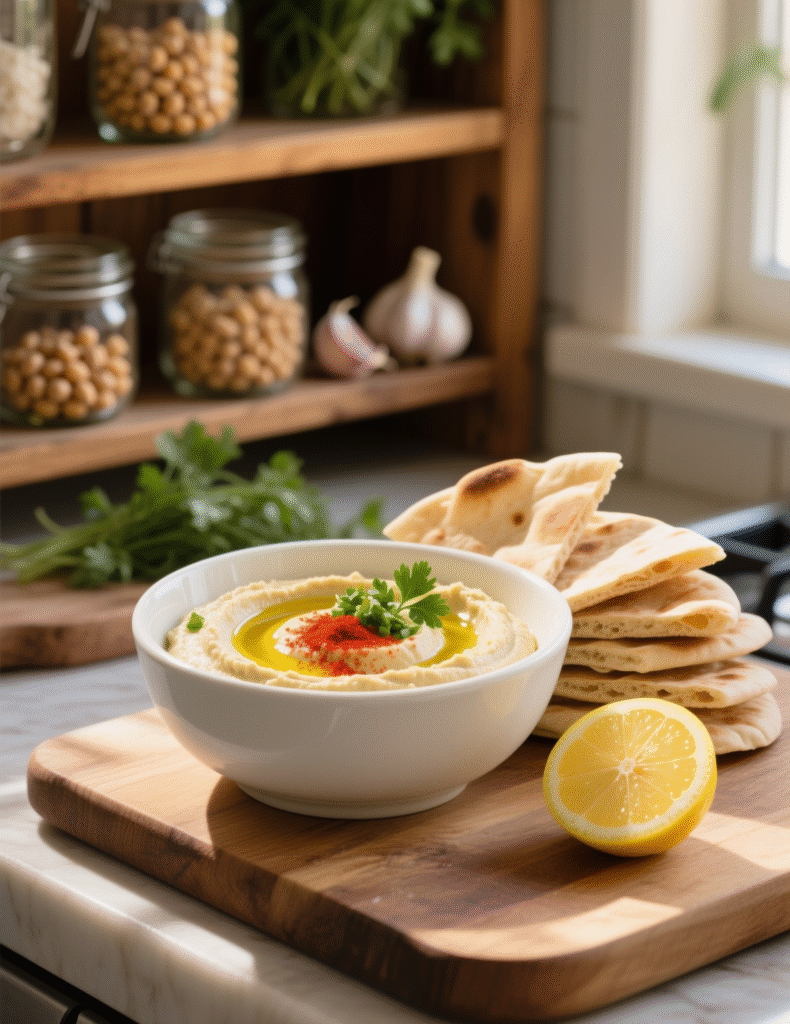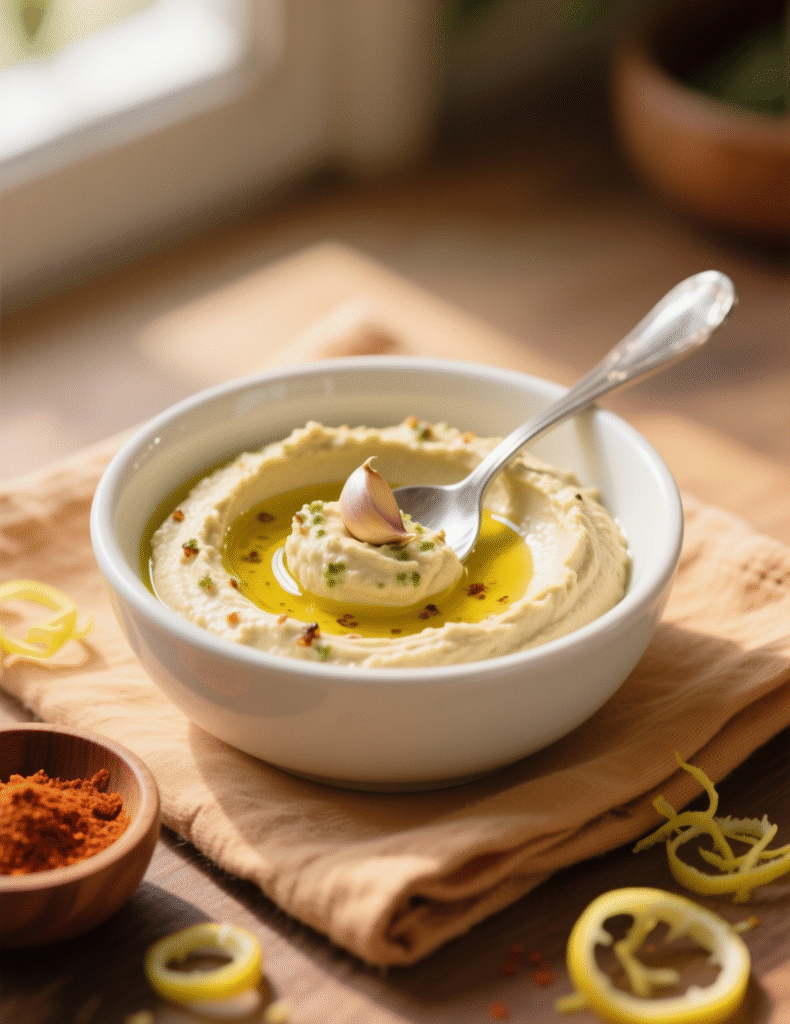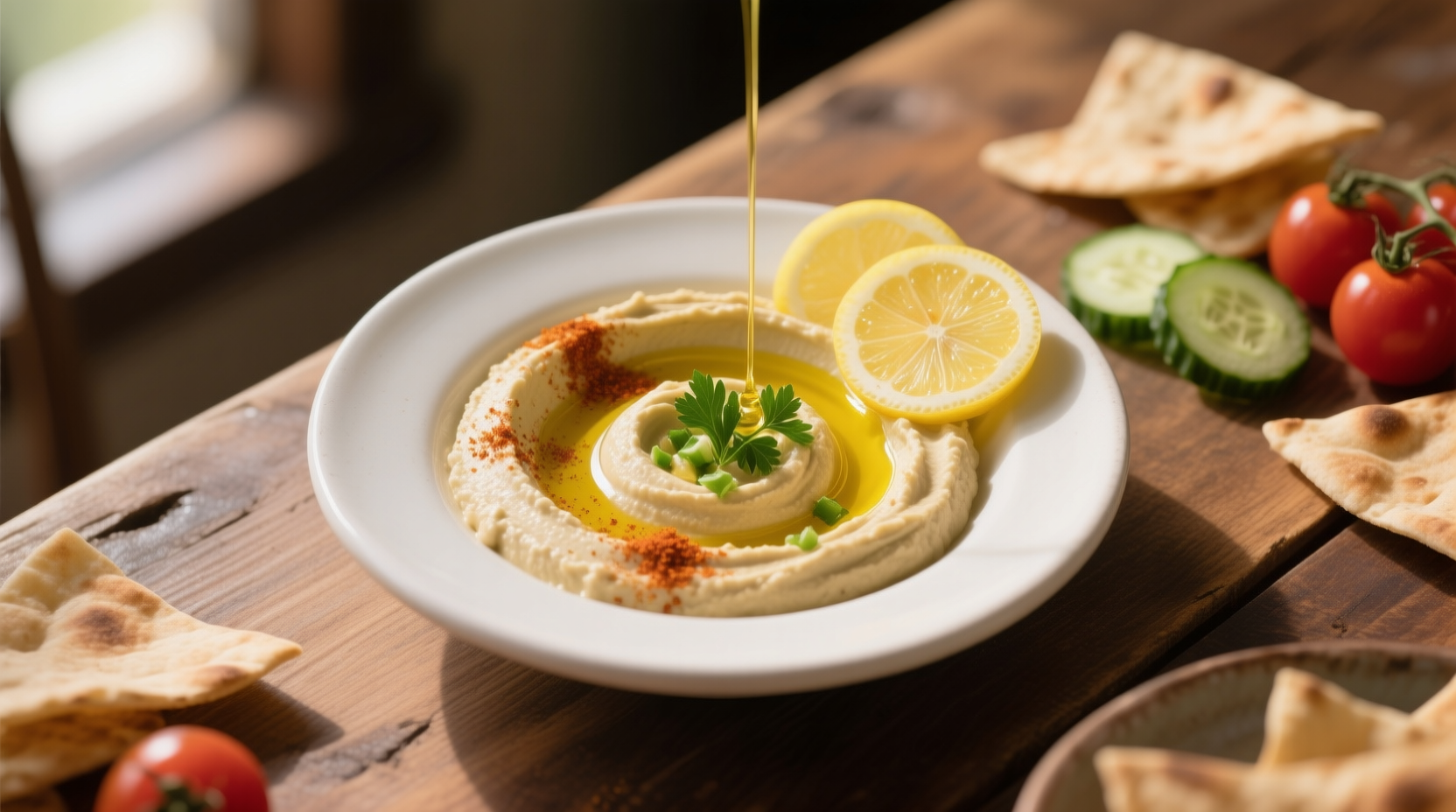If hummus was a language, lemon and garlic would be the punctuation marks that give it meaning. That bright, citrus tang cutting through the creamy chickpeas, the warm whisper of garlic mingling in – it’s enough to make you forget you’re technically eating something healthy. This isn’t the same tired dip you’ve tasted at dull potlucks. It’s the type that makes pita bread disappear faster than you can say “who’s got the olive oil?”. We’re diving deep into the art and science of making a professional-grade lemon garlic hummus that actually tastes like it belongs on a chef’s table, not just your kitchen counter.
Why Lemon and Garlic Make Hummus Sing
Chickpeas on their own? A bit flat. Nutty, yes, but lacking that spark. Lemon brings acidity – the culinary amplifier that wakes up every other flavor. Garlic brings depth – a slow burn of savoriness that lingers in the background. The key here is balance. Too much garlic and you’ve got a vampire-repelling spread. Too much lemon and you’ve wandered into salad dressing territory.
Professional kitchens treat this balance like seasoning a stock – you taste, tweak, and taste again. It’s a conversation between acid and aromatics. And unlike the pre-made supermarket tubs, where the lemon is more of a suggestion, you’re going to make it shout without screaming.
Choosing the Best Ingredients – Yes, It Matters
Here’s where many home cooks (and even some pros in a rush) mess up: assuming hummus is forgiving. It’s not. You can taste stale chickpeas. You can tell when the tahini is from the bottom of a jar that’s been in the fridge since last Ramadan.
Chickpeas – The gold standard is dried chickpeas soaked overnight, then simmered until tender enough to crush between your fingers. Canned works if you’re in a hurry, but rinse them like they’ve personally offended you. A 2019 food science study from the University of Leeds found that prolonged soaking and cooking actually reduces the bean’s “beany” aldehyde compounds, resulting in a sweeter, cleaner flavor.
Tahini – Go for 100% sesame seed tahini, preferably stone-ground. Lebanese or Palestinian brands often have a silkier texture. If your tahini tastes bitter, your hummus will too, no matter how much lemon you add.
Lemon Juice – Fresh, never bottled. The difference is night and day. Cold-pressed lemon juice retains volatile aroma compounds like limonene and citral, which degrade rapidly in processed versions.
Garlic – Fresh cloves, not pre-minced jars (which taste faintly like regret). For a softer garlic flavor, roast it. For sharper, use raw but remove the green germ to avoid bitterness.
Olive Oil – Extra virgin, fruity, with low bitterness. You’re not just blending it in; you’re drizzling it on top to finish, so it’s part of the eating experience.

Prepping Chickpeas Like a Pro
If you’ve only ever drained a can of chickpeas, you might not know this: peeling the skins changes everything. Yes, it’s tedious. Yes, it’s worth it. That thin outer layer traps starch granules, creating a slightly gritty texture. Remove it, and your hummus goes from “rustic” to “Michelin-star smooth.”
Here’s the trick chefs use – after boiling, shock the chickpeas in ice water and gently rub them between your hands. Skins float to the top like little beige ghosts. Scoop them away. A test kitchen trial at Cook’s Illustrated found that skinless chickpeas produced hummus with 30% less graininess.
The Garlic Question – Raw or Roasted?
It’s a culinary debate as old as hummus itself. Raw garlic is punchy, intense, and unapologetic. Roasted garlic is mellow, almost sweet, with nutty undertones. In a professional setting, I often blend the two – one clove raw for backbone, two cloves roasted for depth.
Roasting tip: leave the skin on, slice the top off, drizzle with olive oil, wrap in foil, and roast at 375°F (190°C) for about 35 minutes. Squeeze out the softened cloves like toothpaste.
The Lemon Layering Technique
Most people just dump in lemon juice and call it a day. But in pro kitchens, we build acidity in stages. Start with half the juice, blend, taste, then adjust. Acidity interacts with salt, so you don’t want to over-lemon early and then find your hummus oddly flat after salting.
For extra aromatic lift, add a bit of lemon zest. The oils in the zest are pure sunshine in a bottle. Just don’t overdo it – you want brightness, not a cleaning product vibe.
The Blend – Where Texture is Born
You can’t just throw everything in a blender and hit “go” if you want restaurant-quality hummus. There’s a sequence:
- Tahini & Lemon First – Blend tahini with lemon juice until it thickens and turns pale. This emulsifies the sesame oils, giving you a creamier base.
- Add Garlic & Seasoning – Blend in garlic, salt, and cumin (if using) for even distribution.
- Introduce Chickpeas Slowly – Add in batches, blending fully before adding more.
- Thin with Ice Water – Ice water creates tiny air bubbles, making hummus fluffier. Professionals often use 3–5 tablespoons.
A food processor is standard, but high-speed blenders give unmatched silkiness. Just don’t overblend once the chickpeas are in; friction heat can make the hummus gummy.
Professional Garnish & Presentation
Chefs know hummus is 50% flavor, 50% presentation. Smooth the top with the back of a spoon, then make a shallow spiral groove to catch olive oil. Sprinkle with paprika, za’atar, or toasted sesame seeds. A scattering of chopped parsley or pomegranate seeds adds color and freshness.
If you’re serving in a restaurant setting, warm the hummus slightly before plating. Cold hummus mutes flavors. Room temperature or gently warmed lets the lemon and garlic bloom.

Common Mistakes That Ruin Hummus
- Using Old Ingredients – Chickpeas and tahini lose flavor over time.
- Over-Garlicking – More isn’t better; it’s just louder.
- Skipping the Ice Water – Makes texture dense, not airy.
- Serving Straight from the Fridge – Flavor is trapped until warmed.
Emerging Trends – Hummus in Modern Cuisine
Hummus isn’t just for dipping anymore. Chefs are using lemon garlic hummus as a base for grain bowls, as a spread on artisanal sandwiches, even as a creamy component in vegan pasta sauces. Data from the Plant Based Foods Association shows a 21% increase in hummus-based menu items in US restaurants over the last five years.
There’s also a growing move toward heritage chickpeas – older cultivars with richer flavor. In Spain’s Castilla-La Mancha region, for instance, small farms are reviving “garbanzo pedrosillano,” prized for its sweeter profile.
Lemon Garlic Hummus – The Recipe
Ingredients:
- 1 cup dried chickpeas (or 2 cans, drained & rinsed)
- ½ cup high-quality tahini
- Juice of 2–3 lemons (adjust to taste)
- Zest of 1 lemon
- 1 clove raw garlic, minced
- 2 cloves roasted garlic
- 4–5 tbsp ice water
- 3 tbsp extra virgin olive oil (plus more for drizzling)
- 1 tsp sea salt (adjust as needed)
- Optional: ½ tsp ground cumin
Method:
- If using dried chickpeas, soak overnight in plenty of water. Drain, rinse, and simmer in fresh water until very soft (about 1½ hours). Peel skins for ultra-smooth texture.
- In a food processor, blend tahini and lemon juice until thick and creamy.
- Add raw and roasted garlic, salt, and cumin. Blend again.
- Add chickpeas in batches, blending fully each time.
- Slowly add ice water until desired consistency is reached.
- Taste and adjust lemon and salt.
- Spread in a shallow dish, drizzle with olive oil, and garnish. Serve warm or at room temp.
Final Thoughts – The Difference Between Ordinary and Exceptional
Lemon garlic hummus done well is deceptively simple. It’s proof that small details – peeling chickpeas, balancing acid, layering garlic – add up to something far beyond the sum of its parts. A tub from the store might pass for a snack. But this? This is a statement.
And here’s the unglamorous truth: even professionals have to make it more than once to nail their perfect balance. Your lemons might be sweeter one week, your garlic sharper another. The art lies in adjusting, not following a recipe like it’s a court order.
If you treat every batch like a conversation with the ingredients, you’ll never go back to “good enough” hummus again.
FAQs
How can I make my hummus extra smooth?
Peel the chickpea skins and blend with ice water for a silky texture.
Can I use bottled lemon juice for hummus?
Fresh lemon juice is best, as bottled lacks the bright citrus oils.
Should garlic be raw or roasted for hummus?
You can use both—raw for sharpness, roasted for sweetness and depth.
Is tahini necessary in hummus?
Yes, it adds creaminess and a nutty flavor essential to authentic hummus.
Can I make hummus without a food processor?
Yes, but a blender or mortar and pestle requires more effort and may be less smooth.
How long does homemade hummus last?
Stored in an airtight container, it lasts about 4–5 days in the fridge.
Can I freeze lemon garlic hummus?
Yes, though texture may slightly change after thawing.
Why does my hummus taste bitter?
Usually from low-quality or old tahini; always taste it before using.
Should hummus be served cold or warm?
Room temperature or slightly warm enhances its flavor.
Can I make hummus without tahini?
Yes, but it will lack the signature creaminess and sesame flavor.

Mariana is a passionate home cook who creates delicious, easy-to-follow recipes for busy people. From energizing breakfasts to satisfying dinners and indulgent desserts, her dishes are designed to fuel both your body and hustle.
When she’s not in the kitchen, she’s exploring new flavors and dreaming up her next recipe to share with the Foodie Hustle community.

